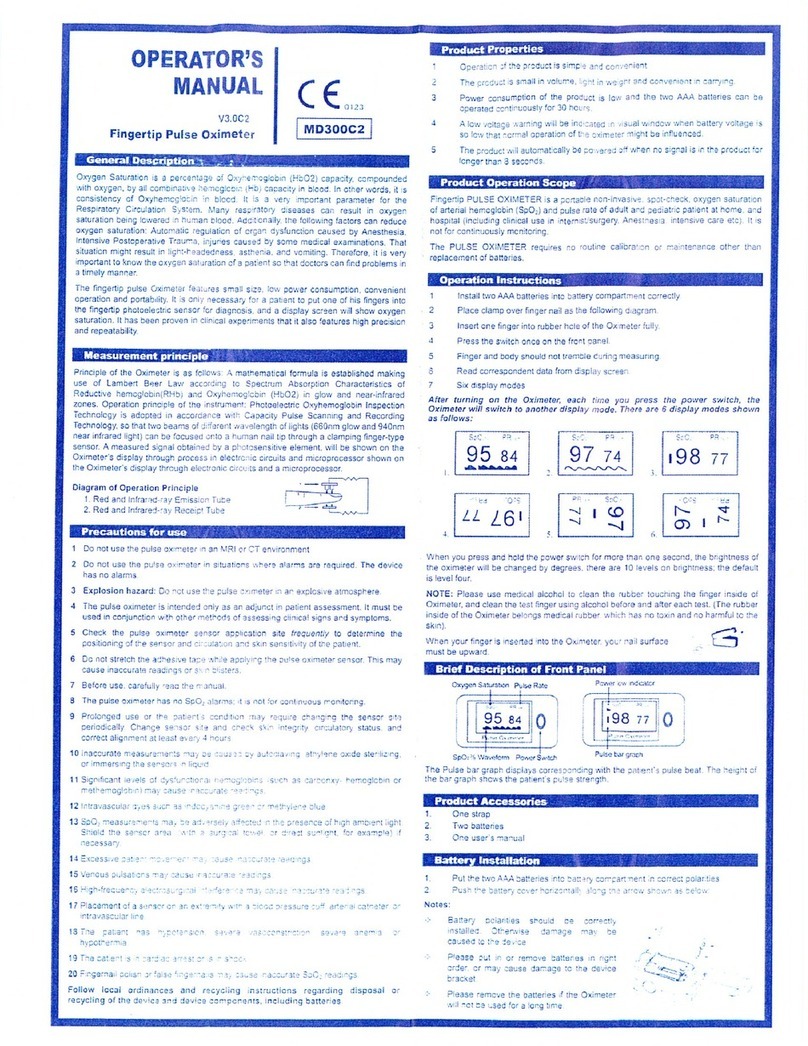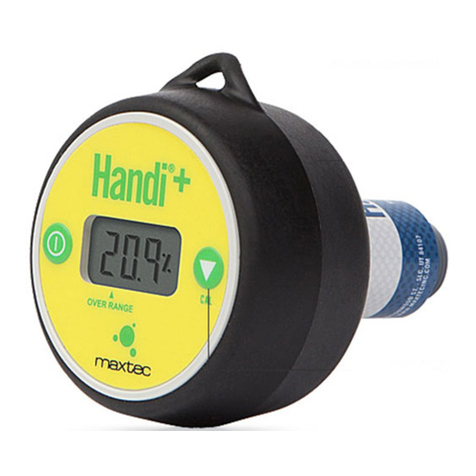
II 866.4.Maxtec www.maxtec.com
NOTE: In order to obtain optimum performance from your MaxO2ME monitor, all operation
and maintenance must be performed in accordance with this manual. Please read the
manual thoroughly before using the monitor and do not attempt any repair or procedure
that is not described herein. Maxtec cannot warrant any damage resulting from misuse,
unauthorized repair or improper maintenance of the instrument.
WARNINGS
FAILURE TO COMPLY WITH THESE WARNINGS AND CAUTIONS COULD RESULT
IN INSTRUMENT DAMAGE AND POSSIBLY JEOPARDIZE THE WELL BEING OF THE
PATIENT AND/OR HEALTH CARE PROFESSIONAL.
»Before use, all individuals who will be using the MaxO2ME must become thoroughly familiar with
the information contained in this Operation Manual. Strict adherence to the operating instructions
is necessary for safe effective product performance. This product will perform only as designed if
installed and operated in accordance with the manufacturer’s operating instructions.
»This product is not intended as a life-sustaining or life-supporting device.
»Medical Oxygen should meet the requirements of USP.
»The Alarm limits can be set to levels that would render them useless for a particular patient's clinical
condition. Ensure that the delivered oxygen level and flow rate are set to values prescribed by the
patient's physician. Also ensure that the high and low alarm limits are set to levels such that they
will sound if the oxygen level is outside of safe limits. Be sure to review and, if necessary, re-set the
alarm limits when the patient's clinical condition changes or when the patient's physician prescribes a
change in oxygen therapy.
»To avoid explosion, DO NOT operate the oxygen monitor in the presence of flammable anesthetics
or in an atmosphere of explosive gases. Operating the oxygen monitor in flammable or explosive
atmospheres may result in fire or explosion.
»Never allow an excess length of cable near the patient’s head or neck, as such could result in
strangulation. Secure excess cable to the bed rail or suitable object.
»Never use a MaxO2ME monitor with a cable that appears worn, cracked or has damaged insulation.
» The oxygen sensors contain a weak acidic solution encapsulated in a plastic housing. Under
normal operating conditions the solution (electrolyte) is never exposed. In case of a leak or if
damaged, DO NOT use the oxygen sensor.
»Use only genuine Maxtec accessories and replacement parts. Failure to do so may seriously
impair the monitor’s performance. Repair or alteration of the MaxO2ME beyond the scope of the
maintenance instructions or by anyone other than an authorized Maxtec service person could cause
the product to fail to perform as designed. No modification of this equipment allowed.
»Calibrate the MaxO2ME weekly when in operation and if environmental conditions change significantly.
(I.e., Temperature, Humidity, Barometric Pressure. Refer to Calibration section of this manual).
»Use of the MaxO2ME near devices that generate electrical fields may cause erratic readings.
»If the MaxO2ME is ever exposed to liquids (from spills or immersion) or to any other physical abuse,
turn the instrument OFF, remove batteries and allow to dry completely, then power ON. This will allow
the unit to go through its self test and make sure everything is operating correctly.
»Never autoclave, immerse in liquid or expose the MaxO2ME (including sensor) to high temperatures
(>50°C). Never expose the device to liquid, pressure, irradiation vacuum, steam, or chemicals.
»To protect the unit from potential leaky battery damage always remove batteries when the unit is going
to be stored (not in use for 30 days or more) and replace dead batteries with recognized name brand
AA Alkaline batteries.
DO NOT use rechargeable batteries.
» This device does not contain automatic barometric pressure compensation.
» Not for use in an MRI environment.
» Battery replacement by inadequately trained personnel could result in a safety hazard.
» Electrical shock or damage to the equipment may occur if an inappropriate external power
supply is used. Maxtec recommends using only the Maxtec approved external power supply, as
listed in 9.0 Spare Parts and Accessories.
































